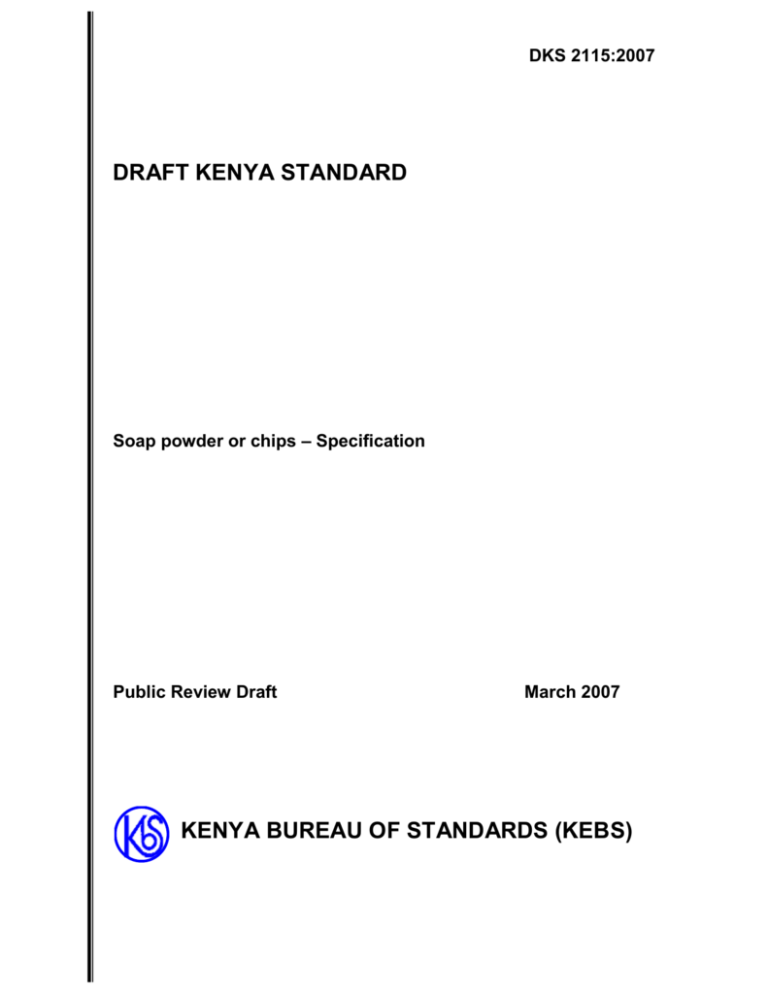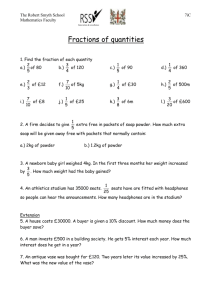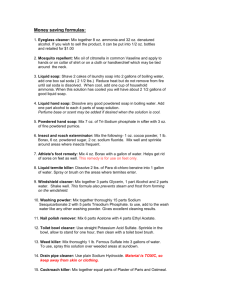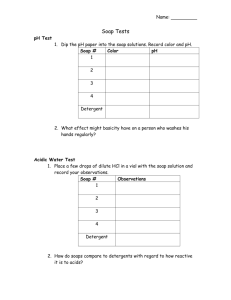
DKS 2115:2007
DRAFT KENYA STANDARD
Soap powder or chips – Specification
Public Review Draft
March 2007
KENYA BUREAU OF STANDARDS (KEBS)
DKS 2115:2007
TECHNICAL COMMITTEE REPRESENTATION
The following organizations were represented on the Technical Committee:
PZ Cussons EA
Unilever Kenya
BIDCO (K) Ltd.
Mep Chemical Industries
K.I.R.D.I
Government Chemist
University of Nairobi
Sanchem Enterprises Ltd.
Consumer Information Network
Haco Industries
Kenya bureau of standards – Secretariat
REVISION OF KENYA STANDARDS
In order to keep abreast of progress in industry, Kenya Standards shall be regularly reviewed.
Suggestions for improvements to published standards, addressed to the Managing Director,
Kenya Bureau of Standards, are welcome.
© Kenya Bureau of Standards. 2007
Copyright. Users are reminded that by virtue of section 6 of the Copyright Act, Cap. 130 of the Laws of
Kenya, copyright subsists in all Kenya Standards and except as provided under section 7 of this Act, no
Kenya Standard produced by Kenya Bureau of Standards may be reproduced, stored in a retrieval system in
any form or transmitted by any means without prior permission in writing from the Managing Director.
ii
© KEBS 2007 All rights reserved
DKS 2115:2007
DRAFT KENYA STANDARD
Soap powder or chips – Specification
KENYA BUREAU OF STANDARDS (KEBS)
Head Office: P.O. Box 54974 - 00200, Nairobi, Tel.: (+254 020) 605490, 602350, Fax: (+254 020) 604031
E-Mail: info@kebs.org, Web: http://www.kebs.org
Coast Region
P.O. Box 99376 - 80100, Mombasa
Tel.: (+254 041) 2229563, 2230938/40
Fax: (+254 041) 229448
E-mail: kebs_msa@swiftmombasa.com
© KEBS 2007 All rights reserved
Lake Region
P.O. Box 2949 - 40100, Kisumu
Tel.: (+254 057) 23549, 22396
Fax: (+254 057) 21814
E-mail: kebs_ksm@swiftkisumu.com
North Rift Region
P.O. Box 2138 - 20100, Nakuru
Tel.: (+254 051) 2210553, 2210555
Fax: (+254 051) 2210076
iii
DKS 2115:2007
Foreword
This Kenya standard was developed by the Technical Committee on Soaps and Detergents
under the guidance of the Chemical Industry Committee, and is in accordance with the
procedures of the Bureau.
During the preparation of this standard, reference was made to the following document:
SABS 245:2000: Specification for Soap powder or chips
Acknowledgement is hereby made for assistance derived from this source.
iv
© KEBS 2007 – All rights reserved
KENYA STANDARD
DKS 2115: 2007
Soap powder or chips – Specification
1
Scope
This Kenya standard specifies requirements and methods of test for four types of soap for use in
laundry.
2
Normative references
This Kenya Standard incorporates by dated and undated reference, provisions from other
publications. These normative references are cited at the appropriate place in the text and the
publications are listed hereafter. For dated references, subsequent amendments to or revisions of
any of these publications apply to this Kenya Standard only when incorporated in it by
amendment or revision. For undated references the latest edition of the publication referred to
applies.
KS 45: Methods of analysis for soaps
ISO 684:1974: Analysis of soaps - Determination of total free alkali
ISO 4323:1977: Soaps - Determination of chlorides content - Potentiometric method
ISO 1067:1974: Analysis of soaps - Determination of unsaponifiable, unsaponified and
unsaponified saponifiable matter
ISO 457:1983: Soaps - Determination of chloride content - Titrimetric method
ISO 685:1975: Analysis of soaps - Determination of total alkali content and total fatty matter
content
ASTM D 502-89: Test method for particle size of soaps and other detergents
3.
Definitions
For the purpose of this specification the following definitions shall apply:
3.1
Batch Soap manufactured from one boil or, in the case of continuous production
processes, the material from a single day’s production.
3.2
Boil
Soap from pan or vat.
3.4
Defective
Soap or its container that fails in one or more respects to comply with the
appropriate requirements of the specification.
3.5
Lot
That quantity of soap powder or chips bearing the same batch identification and
from one manufacturer, submitted at any one time for inspection and testing.
4.
Requirements
4.1
Types
The soap shall be of one of the following types
Type I High titre soap powder or chips intended for washing at high temperatures with soft
water.
Type II Low titre soap powder or chips intended for washing at low temperatures with soft water,
where the presence of alkaline salts is not desirable.
© KEBS 2007 – All rights reserved
1
DKS 2115:2007
Type III High titre, mildly built laundry soap powder intended for general purpose washing with
soft water, where the presence of an equal ratio of soap to alkaline salts is desirable.
Type IV High titre, fully built laundry soap powder intended for high temperature washing with soft
water, where the presence of a high ratio of alkaline salts to soap is desirable.
4.2
General
4.2.1 The soap shall be uniform, free flowing and it shall not contain ingredients in quantities
that are toxic to human beings.
4.2.2 It shall possess good lathering properties in water at ambient temperature and having a
hardness (expressed as calcium carbonate) of 200 p.p.m.
4.2.3 When stored or transported under normal conditions in its original container, the soap
shall not cake into hard lumps.
4.3
Odour
The soap, both as received and when dissolved in hot water, shall possess a pleasant, fresh
odour and shall not develop an objectionable one during storage at ambient temperature.
4.4
Detailed requirements
The soap shall comply with the relevant requirements given in table 1.
2
© KEBS 2007 – All rights reserved
DKS 2115:2007
Table 1: Detailed requirements
Sl.
No.
Requirement
Property
Type
I
Type
II
Type
III
Type
IV
0.2
0.2
0.25
0.25
90.0
1.0
90.0
1.0
70.0
1.0
70.0
1.0
82.0
82.0
40.0
22.0
1.0
1.0
1.0
1.0
1.0
1.0
0.5
0.3
-
-
15.0
25
1.0
1.0
1.0
1.0
1.0
1.0
1.0
1.0
3.0
3.0
3.0
1.0
38.0
-
27.0
-
38.0
0.5
38.0
0.5
1) Free alkali content* (as NaOH), % (m/m),
2)
3)
4)
max
Anhydrous matter content+, % (m/m), min
Ratio between (the actual anhydrous matter
content+ x the average mass of units ‡) and
(the specified minimum anhydrous matter
content x the marked unit mass), min
Fatty matter content+, % (m/m), min
5) Ratio between (the actual fatty matter
content+ x the average mass of units ‡) and
(the specified minimum fatty matter content
x the marked unit mass), min
6) Unsaponified plus unsaponifiable matter
content*, % (m/m) max
7) Total alkali content+ (as sodium hydroxide),
% (m/m), min
8) Water insoluble matter content*, % (m/m),
max
9) Chloride content* (as sodium chloride), %
(m/m), max.
10) Rosin content of fatty matter, % (m/m), max
11) Titre of fatty matter, oC, min.
Max.
12) Fineness of soap powder:
Retained on a 2.80 mm aperture sieve,
% (m/m), max.
Test
Method
KS ISO
684
Annex A
-
KS ISO
685
-
KS ISO
1067
KS ISO
685
KS 45
Clause 4
KS ISO
457/4323
KS 45
Clause 9
Annex B
ASTM D
502-89
* Corrected to a fatty content of 82 % (m/m) for type I and type II soap powders,
40 % (m/m) for type III soap powder, and
22 % (m/m) for type IV soap powder.
+ On the soap as received
‡ See 6.1 (b).
2
© KEBS 2007 – All rights reserved
DKS 2115:2007
5.
Packing and marking
5.1
Packing
The soap powder or chips shall be so packed as to prevent excessive drying out, leakage, or
contamination of the product.
The product shall be packed in containers that are strong enough to withstand normal usage and
transportation. These containers may then be packed in bulk packages
5.2
Marking
Each container and bulk package shall bear (in prominent, legible, and indelible marking) the
following particulars:
i)
ii)
iii)
iv)
v)
vi)
vii)
viii)
ix)
Words indicating that the product is a soap powder or soap chips as relevant and the type
The name and address of the manufacturer and trade mark if any.
The net weight of the contents
In the case of bulk packages, the number of containers
All ingredients except moisture
Batch number or code number
Instructions for use
Storage instructions
Country of origin
6
Sampling and compliance with the specification2)
6.1
Sampling
The following sampling procedure shall be applied in determining whether a lot complies with the
appropriate requirements of the specification. The samples so drawn shall be deemed to present
the lot.
a)
From the lot take at random
1)
2)
if the lot is packed in containers of net mass not exceeding 5 kg: five containers;
if the lot is packed in containers of net mass greater than 5 kg: three containers.
b)
Weigh the contents of each container taken in accordance with (a) above, record these
masses, and calculate the average mass. Take enough soap powder from each container to
provide a composite sample of total mass at least 1 kg (take approximately equal quantities of
soap powder from all containers). Immediately place the sample so drawn in a clean, dry, airtight glass or plastic container clearly marked with the manufacturer’s name or trade mark, the
batch identification, and the date of sampling.
Note
The contents of each container shall be thoroughly mixed before sampling.
6.2
Compliance with the specification
The lot shall be deemed to comply with the requirements of the specification if, after inspection
and testing of the samples taken in accordance with 6.1, no defective is found.
This section applies to the sampling for inspection and testing before acceptance or rejection of single lots
(consignments) in cases where no information about the implementation of quality control or testing during manufacture
is available to help in assessing the quality of the lot. It is also used as the procedure for adjudicating in cases of dispute.
2)
© KEBS 2007 – All rights reserved
3
DKS 2115:2007
7
Inspection
Inspect the containers taken in accordance with 6.1 for compliance with the requirements of
section 5.
8
Preparation of test samples
8.1
Composite sample
Mix the sample, taken in accordance with 6.1(b), thoroughly by hand in the original sample
container for at least 2 min
8.1.1
Sample for testing
Immediately after mixing the composite sample take at one time all test samples required. Weigh
out last the test sample required for the determination of free alkali content and use it
immediately.
Note
Ensure that any loss or pick-up of moisture is reduced to a minimum by carrying out the weighing
and the preparation of the sample as rapidly as possible.
4
© KEBS 2007 – All rights reserved
DKS 2115:2007
Annex A
Determination of anhydrous matter content
A.1
Apparatus
A.1.1 Flask ― A flask of 500 ml capacity, having a ground-joint neck, and with a round bottom
(if a heating mantle is to be used as the means of heating), or with a flat bottom (if a hotplate is to
be used as the means of heating).
A.1.2
Condenser ― See Fig. 1
A.1.3 Receiver ― A dean and stark type receiver of one of the following sizes, depending on
the expected water content of the sample:
a)
2 ml capacity graduated in 0.05 ml divisions, for Type I and Type II soap powders (see
Fig. 2).
b)
7.5 ml capacity graduated in 0.1 ml divisions, for Type III and Type IV soap powders (see
Fig. 3).
A.1.4
Source of heat ― A heating mantle for 500 ml flasks or a hotplate.
Note
Before assembling the apparatus, clean the receiver and the inner tube of the condenser
thoroughly with chromic-sulphuric acid, then rinse with distilled water followed by acetone, and dry in an
oven.
A.2
Reagents
Note
Use only analytical grade reagents and carbon dioxide-free distilled water.
2. A.1 Toluene ― Shake toluene vigorously for approximately 30s with a small quantity of
water. Let the water settle, then decant the clear toluene into a distillation flask and distil it.
Discard the first, normally turbid fraction of the distillate and use only the following clear fraction
for the determination.
A.2.2
Anhydrous sodium acetate ― Sodium acetate dried at 105 ± 5oC to constant mass.
A.3
Procedure
A.3.1 Weigh, to the nearest 0.1 g approximately 20 g of the test sample into the flask. Add to it
approximately 10 g of the anhydrous sodium acetate (to prevent violent frothing), 3 - 5 glass
beads, and 100 ml of the toluene. Assemble the apparatus and fill the receiver with the toluene by
pouring 50 ml of it through the reflux condenser. In order to ensure better control of the
distillation, wrap the flask and the tube leading to the receiver in asbestos cloth.
A.3.2 Heat the contents of the flask to moderate boiling. At the start the distillation rate should
be approximately 100 drops per min, and when the greater part of the water has distilled, the rate
should be increased to approximately 200 drops per min. Reflux for at least 2 h.
Note
Rinse down the reflux condenser during the distillation process with small portions of the toluene in
order to collect any water droplets that might adhere to the condenser tube. Any toluene trapped inside the
graduated tube of the receiver may be separated from the distilled water by moving a spiral copper wire up
and down inside the tube.
© KEBS 2007 – All rights reserved
5
DKS 2115:2007
A.3.3 Disconnect the apparatus, allow the receiver to cool to room temperature, and record the
volume of the water in the graduated tube.
Note
When the water volume is read, there shall be no emulsified zone between the solvent and the
water layer.
A.4
Calculation
4.1
Anhydrous matter content, % (m/m)
= 100
A 100
B
Where
A = volume of water distilled, ml
B = mass of the test sample used, g
6
© KEBS 2007 – All rights reserved
DKS 2115:2007
Annex B
Determination of Titre of fatty matter (Metric units)
B.1
Apparatus (see Fig. 1)
B.1.1
Water bath ― A two litre low-form beaker
B.1.2 Wide-mouth bottle ― An approximately 450 ml bottle that is about 190 mm high,
having a neck of inside diameter approximately 40 mm and fitted with a cork that holds the test
tube (B.1.3). The bottle contains sufficient lead shot or other dense ballast to hold it steady when
placed in the water bath.
B.1.3 Test tube ― A test tube of length 100 mm, of inside diameter 25 mm, and marked 57
mm from the bottom to indicate the level to which the sample should be added. It is fitted with a
bored cork to support the stirrer and the titre-test thermometer.
B.1.4 Stirrer ― A stirrer made from glass or stainless steel of diameter 2-3 mm, and with the
lower end formed into a loop 19 mm in diameter. The upper end of the stirrer is shaped as a
handle for hand operation.
B.1.5
Laboratory thermometer ― A 0 -150oC thermometer
B.1.6 Titre-test thermometer ― An ASTM titre-test thermometer, having a range of -2 to
+68oC and conforming to the relevant requirements given in ASTM designation E1.
B.2
Procedure
B.2.1 Heat the fatty matter (retained from the determination of rosin content) to a temperature
approximately 10oC above the expected titre and pour sufficient into the test tube to reach the 57
mm mark. Fit the test tube in the wide-mouth bottle and place the assembly in the water bath.
The water level should be approximately 10 mm above the 57 mm mark on the test tube. Adjust
the temperature of the water bath to 20oC below the expected titre (for titres 35oC and over) or to
15-20oC below expected titre (for titres below 35oC).
B.2.2 Ensure that the titre-test thermometer is situated approximately along the axis of the test
tube and at such a height that the immersion mark coincides with the top of the sample of fatty
matter.
B.2.3 When the titre-test thermometer reads 10oC above the expected titre, commence stirring
at the rate of about 100 completed up and down strokes per min. (The stirrer should travel
through a distance of approximately 40 mm on each stroke.) Read the thermometer every 15s
and continue stirring until the temperature remains constant for 30s or just begins to rise. At this
point stop stirring, and note the rise in temperature. Record the highest temperature reached.
B.2.4
Repeat the procedure given in B.2.1 – B.2.3
B.2.5 The recorded temperatures of the two determinations shall not differ by more than 0.2 oC.
(If the difference exceeds 0.2oC, repeat the determination until two readings agree). Report as the
titre of the fatty matter, the mean of the tow temperature readings that agree to within 0.2oC.
© KEBS 2007 – All rights reserved
7








